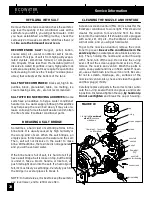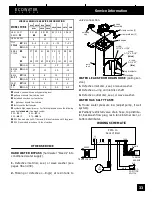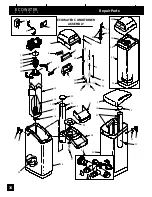
ECOWATER
S Y S T E
M S
Service Information
28
REFILLING WITH SALT
Remove the brine tank cover and check the salt stor-
age level frequently. If the conditioner uses all the
salt before you refill it, you will get hard water. Until
you have established a refilling routine, check the
salt every 2 or 3 weeks. ALWAYS refill if less than 1/2
full.
Be sure the brinewell cover is on.
RECOMMENDED SALT:
Nugget, pellet, button,
coarse solar, etc., water conditioner salt is recom-
mended. This type of salt is from high purity evapo-
rated crystals, sometimes formed, or compressed,
into briquets. It has less than 1% insoluble (will not
dissolve in water) impurities.
Clean, high grade
rock
salts are acceptable, but may require frequent brine
tank cleaning to remove the ‘‘sludge’’residue (insol-
ubles) that collects at the bottom of the tank.
SALT NOT RECOMMENDED:
Rock salt, high in im-
purities, block, granulated, table, ice melting, ice
cream making salts, etc., are not recommended.
SALT WITH IRON REMOVING ADDITIVES:
Some
salts have an additive to help a water conditioner
handle iron in a water supply. Although this additive
may help keep the resin bed clean, it may also re-
lease corrosive fumes that will weaken and shorten
the life of some EcoWater conditioner parts.
BREAKING A SALT BRIDGE
Sometimes, a hard crust or salt bridge forms in the
brine tank. It is usually caused by high humidity or
the wrong kind of salt. When the salt bridges, an
empty space forms between the water and the salt.
Then, salt will not dissolve in the water to make
brine. Without brine, the resin bed is not regenerated
and you will have hard water.
If the brine tank is full of salt, it is hard to tell if you
have a salt bridge. Salt is loose on top, but the bridge
is under it. Take a broom handle, or like tool, and
push it straight down into the salt. If a hard object is
felt, it’s most likely a salt bridge.
Carefully
push into
the bridge in several places to break it.
NOTE:
In humid areas, it is best to keep the salt stor-
age level lower, and to refill more often.
CLEANING THE NOZZLE AND VENTURI
A clean nozzle and venturi (FIG. 19) is a must for the
EcoWater conditioner to work right. This small unit
creates the suction to move brine from the brine
tank, into the resin tank. If it should become plugged
with sand, silt, dirt, etc., the EcoWater conditioner
will not work, and you will get hard water.
To get to the nozzle and venturi, remove the condi-
tioner top cover.
Be sure the conditioner is in the
service cycle
(no water pressure at nozzle and ven-
turi). Then, holding the nozzle and venturi housing
with 1 hand, turn off the cap.
Do not lose the o--ring
seal.
Lift out the screen support and screen. Then,
remove the nozzle and venturi. Wash the parts in
warm, soapy water and rinse in fresh water. If need-
ed, use a small brush to remove iron or dirt. Be care-
ful not to scratch, misshape, etc., surfaces of the
nozzle and venturi. Also, check and clean the gasket
and flow plug(s) if dirty.
Carefully replace all parts in the correct order. Lubri-
cate the o--ring seal with silicone grease and locate
in position. Install and tighten the cap,
by hand only.
Do not overtighten
and break the cap or housing.
cap
o--ring
screen support
screen
nozzle &
venturi
gasket
flow plug
À
(fill)
nozzle &
venturi housing
cone screen
flow plug
À
(not used
on all models)
install with
numbered
side UP
,
concave
side down
brine tubing
FIGURE 19
À













































